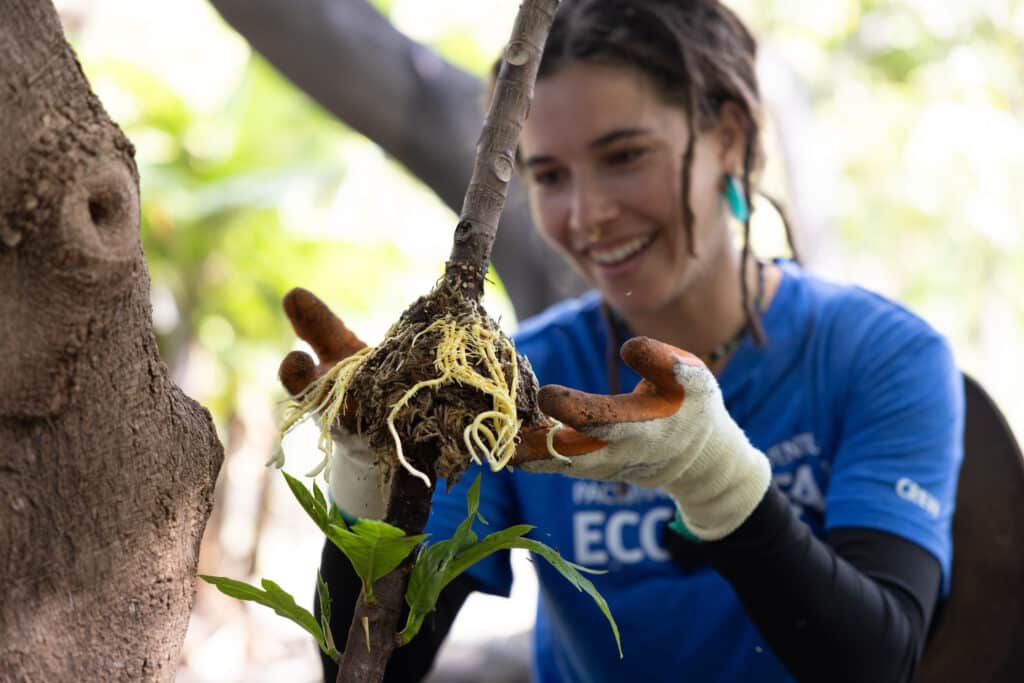Happy Holidays from Pacific Whale Foundation! Everyone is in the holiday spirit, including some of our underwater friends 😉 Did you know that there is marine life found in the waters of Maui whose names are holiday inspired? Here are some ‘Christmas Critters’ to get to know today.
Candy Cane Shrimp

Parhippolyte mistica, the Candy Cane Shrimp can be identified from other similar red and white shrimp by their five or six red bands on a whitish translucent body, which is what gives them their common name. The bright yellow ovaries of the females can often be seen through the top of the carapace or the top of the exoskeleton (shell). The legs are spindly and the antennae are long. They inhabit the deepest recesses of caves and usually live in small groups. They will venture out to the edges of caves, but only at night. They can often be confused with a similar species, P. uveae, but vary in their activity…the latter venture towards the edge of caves by day. In order to see a Candy Cane shrimp, you would most likely have to deep dive in an underwater cave or dive at night. (Information from Hoover, Hawaii’s Sea Creatures)
Christmas Wrasse

Thalassoma trilobatum, were named for their green and red coloration. They are also called ladder wrasses, ‘awela (Hawaiian), and green-barred wrasses, and can be up to 11 inches in length. Wrasses are a big-lipped, spindle-shaped fish that “flap” their pectoral fins up and down while swimming. Males and females exhibit sexual dimorphism in color, and may change color, and even sex, during their lives. Males in their terminal color phase are brightly-colored, while females are green with black lines. The most brilliantly-colored male Christmas wrasses have reddish-pink background coloration on their body with ladder-like stripes that are bright blue and green in color. In its initial phase, a male has a diagonal dark red line below its eye. The head of the male is brown, orange or shaded with blue, while the head of females is spotted. Younger animals of both sexes are a more drab green and brown color. Christmas wrasses feed during the day, and prey upon crustaceans, brittle stars, mollusks, and sometimes small fish, using canine teeth in their upper and lower jaws. Wrasses crush their prey using pharyngeal bones that are located near their gills. Reproduction occurs sexually, with spawning occurring during the day. Males become more intense in color during spawning time, and their fins may be blue or blackish-blue in color. The males display by swimming back and forth and waving their pectoral fins. Males may form a harem with several females. If the primary male in a group dies, a female may change sex to replace him. Christmas wrasses are listed as –of least concern– on the IUCN Red List and are widespread throughout their range. They are fished in limited numbers, but more important to humans for their use in the aquarium trade. The Christmas wrasse’s ability to change colors and sex has caused confusion over the years over species identification.
It also looks similar to another species in a similar habitat – the surge wrasse (Thalassoma purpureum), which is similar in color, although there is a v-shaped mark on their snout which is absent in the Christmas wrasse. (Information from Thoughtco.com)

Source: zsispeo/flicker
Christmas Tree Worms

Spirobranchus giganteus, are also known as the Christmas tree worm. The common name for these worms is derived from their appearance, not their habitat or diet. Each worm has two brightly colored crowns that protrude from its tube-like body. These Christmas tree-like crowns are composed of radioles, or hair-like appendages radiating from the worm’s central spine. These appendages are used for respiration and to catch dinner, which typically consists of microscopic plants, or phytoplankton, floating in the water.
These worms are sedentary, meaning that once they find a place they like, they don’t move much. In fact, while the colorful crowns of these worms are visible, most of their bodies are anchored in burrows that they bore into live coral. When startled, Christmas tree worms rapidly retract into their burrows, hiding from would-be predators. Christmas tree worms come in a variety of bright colors. They aren’t very big, averaging about 1.5 inches in length. However, because of their distinctive shape, beauty, and color, these worms are easily spotted. They are some of the most widely recognized polycheates, or marine burrowing, segmented worms out there. When approached by divers or snorkelers, they will sneak back into their burrow briefly. (Information from NOAA)
Snowflake Moray Eel

Echinda nebulosa, The snowflake eel is relatively small, slender eel with distinctive markings (basically white with large black blotches and tiny yellow and black spots). The front of the head is usually solid white. They do not possess sharp teeth and tend to be shy and timid. They crush their small crab and fish prey with tiny pebble like teeth. They can found in tide pools or depths of up to 90 feet, but are most often found in shallow areas composed of rocky bottom, coral rubble, or on reef flats. This species can reach 71 cm (28in). They can be found throughout the Indo-Pacific and are common in Hawaii at most of our local snorkel locations. (Information from Russo, Hawaiian Reefs)


